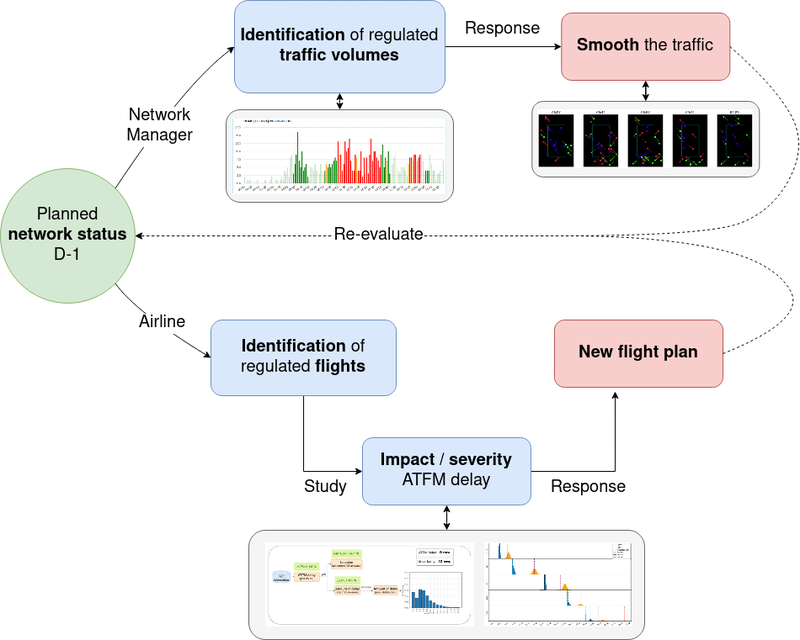Sergi Mas-Pujol defends his thesis on the management of imbalances between demand and air capacity using deep learning techniques
May 17, 2023
Sergi Mas-Pujol defended his thesis co-supervised by Dra. Esther Salamí and Dr. Enric Pastor on May 12, 2023 at the Baix Llobregat Campus. Entitled "Deep Learning techniques for Demand-Capacity Balancing", the thesis studies the use of artificial intelligence techniques to improve the detection of air regulations and how to smooth traffic in periods of high demand, proposing different models that have takes into account the needs of the main parties involved (network management entity and airlines) and a reinforcement learning model based on the use of images.
Nowadays Air Navigation Service Providers (ANSPs) have to handle and accommodate a continuously increasing traffic demand in a scenario that is expected to be more time efficient and cost-efficient. Meeting the demand with the available airspace capacity is one of the most challenging problems faced by Air Traffic Management (ATM). This collaborative Demand-Capacity Balancing process often ends up enforcing Air Traffic Flow Management (ATFM) regulations when capacity cannot be adjusted. The arrival traffic is spread out by assigning delays on the ground at the departure airport, and the arrivals are metered at the congested infrastructure. However, deciding whether and when regulations are needed is time consuming and relies heavily on human knowledge. This leads to suboptimal and unnecessarily long regulation and, therefore, to the realization of unnecessary delay and underuse of the capacity.
Over the years, many researchers have investigated new techniques to estimate better the complexity of a given Air Traffic Control (ATC) sector -- Traffic Volume (TV) -- or how to quantify the workload of the Air Traffic Controllers (ATCOs) to identify required ATFM regulations. Moreover, because of the huge impact of ATFM delays in the network, a wide variety of previous work can be found trying to optimize, improve, minimize, or predict the evolution of delays. The literature shows three main trends: proposals without any Artificial Intelligence (AI), using supervised Machine Learning or Reinforcement Learning (RL) techniques. However, there is a lack of work directly focusing on the identification of required ATFM regulations and their characteristics, and the proposed methods to smooth demand-capacity imbalances suffer from scalability issues. The main objective of this PhD thesis is to investigate the usage of AI techniques to identify and smooth DCB problems leading to ATFM regulations during the pre-tactical phase. That is when there is no available information from the Network Manager (NM) about required regulations and when levels of uncertainty are much higher. Different sets of frameworks are studied and developed, considering the needs and policies of different stakeholders.
First, it is studied the identification of ATFM regulations at the TV level, using supervised techniques and developing a framework that aims to be used by the NM. The two most frequent regulations reasons are analyzed over two of the most congested European Civil Aviation Conference (ECAC) regions. Results reveal that the proposed architecture can identify almost all the regulations during the summer, which is probably the most congested season. Second, RL techniques are investigated to solve the previously identified ATFM regulation, focusing on scalability due to the usage of images. Finally, airlines are the stakeholders affected by ATFM regulations; thus, the potential benefits of identifying ATFM regulations at the flight level are also analyzed. Promising results show it is possible to predict ATFM characteristics using supervised techniques. Moreover, the models are integrated into a framework to assess the impact and severity of issued regulations to anticipate possible reactionary delays for specific aircraft frames.
Overall, results prove it is possible to accurately predict ATFM regulations, the characteristics of such regulations, and automatize the smoothing process required to solve DCB issues. There are some factors to be considered that may limit the benefits of the proposed solutions, starting with data availability issues in some experiments. However, it is worth mentioning that the models have been tested under the most challenging European scenarios. Finally, deploying the proposed framework will be key to studying the benefits and impact of the proposed solution. Therefore, specific advice capabilities are proposed for the visualization of the results taking into account uncertainty.

Share: